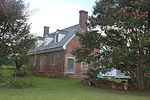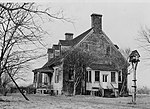Rich Neck Farm

Rich Neck Farm, also known as Richneck Plantation, was a historic home and farm located near Surry, Surry County, Virginia. The house was built about 1802, and was a 11⁄2-story, five-bay, double pile, central-hall plan brick dwelling in a pre-Georgian style. It had a gambrel roof with dormers and sat on a high basement. Long connected with the Ruffins, one of the prominent families of Southside Virginia, Rich Neck possessed a collection of buildings which were among the best preserved and most noteworthy of their type in the region. Original sashes, most of the doors, hinges (many with their leather washers), locks, and other hardware remained. The Ruffin family figured in Virginia's social and intellectual history throughout the colonial and early national periods. Its most notable member was Edmund Ruffin, an ardent secessionist and agricultural pioneer who is considered to be the father of agronomy. Research indicates Rich Neck remained in the Ruffin family until 1865. The house long stood vacant and in a state of disrepair. In 2011 Preservation Virginia listed Rich Neck Farm as one of the most endangered historic sites in Virginia. The house was destroyed by fire in 2012. Also on the property are two contributing granaries, a smokehouse, office, an outhouse, a well house, and a chicken house.Rich Neck Farm was listed on the National Register of Historic Places in 1980.
Excerpt from the Wikipedia article Rich Neck Farm (License: CC BY-SA 3.0, Authors, Images).Rich Neck Farm
Chippokes Farm Road,
Geographical coordinates (GPS) Address Nearby Places Show on map
Geographical coordinates (GPS)
| Latitude | Longitude |
|---|---|
| N 37.125833333333 ° | E -76.751388888889 ° |
Address
Chippokes Farm Road 1579
23883
Virginia, United States
Open on Google Maps









